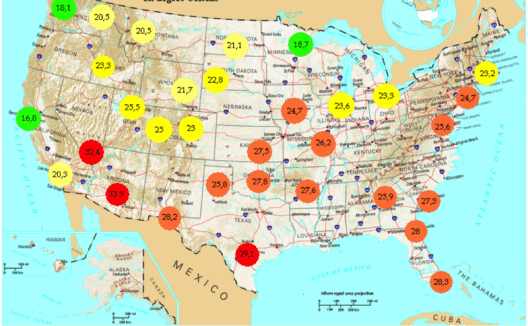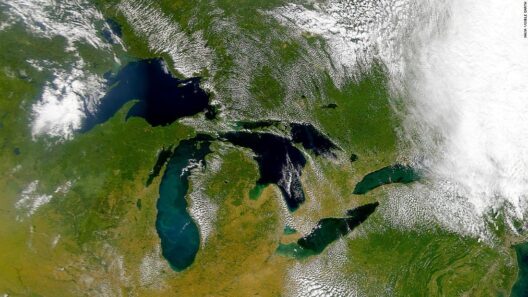Mountains are more than mere geological formations rising majestically from the Earth’s surface; they are profound influencers of climate zones across the planet. Their towering heights and varied slopes create a tapestry of ecological niches, forging microclimates that shape the flora and fauna inhabiting these elevated realms. This interplay between topography and climate is essential to understanding environmental dynamics and the diverse conditions that give rise to different ecosystems. By delving into how mountains control climate zones, we can illuminate the importance of these natural features in the broader context of environmental stewardship and climate change.
At the most fundamental level, mountains influence climate through their topographical characteristics. Elevation plays a pivotal role; as altitude increases, temperature generally decreases. This phenomenon is attributed to the thinning atmosphere, which cannot retain heat as effectively at higher elevations. The concept of the lapse rate illustrates this aspect: for every 1,000 meters of ascent, the temperature drops by approximately 6.5 degrees Celsius, creating distinctive climatic zones that are starkly different from the lowlands below.
One of the most striking examples of mountain-induced climate variation can be seen in the Himalayas. This majestic mountain range not only houses some of the world’s highest peaks but also serves as a colossal barrier. The presence of the Himalayas profoundly affects the monsoon patterns of the Indian subcontinent. As moist air from the Indian Ocean encounters the mountain range, it is forced to ascend. This vertical movement cools the air, leading to precipitation that transforms the region into a fertile landscape. Conversely, the leeward side of the mountains experiences a rain shadow effect, resulting in arid conditions characterized by drastically reduced rainfall.
Further enhancing our understanding of this dynamic, elevation influences not just temperature and precipitation but also wind patterns. Mountains can alter the course of prevailing winds, which in turn affects climate. For instance, the Andes Mountains in South America disrupt the typical easterly trade winds, funneling air and moisture into unique weather patterns across the continent. This modification not only shapes local climates but also impacts broader weather systems, illustrating the scale at which mountains operate in the climatic sphere.
Additionally, the geographical orientation of mountain ranges plays a crucial role in their climatic implications. Ridges that run north to south capture sunlight differently than those oriented east to west. These variations can lead to significant disparities in temperature, moisture availability, and even the types of vegetation that can thrive at different altitudes. Such nuances emphasize the intricate relationship between topography and climate, reinforcing the need for a comprehensive understanding when addressing environmental issues.
In terms of biodiversity, mountains are hotspots for a multitude of species. Their varied ecosystems range from alpine meadows to dense forests, each zone offering unique habitats for a plethora of plant and animal life. The concept of elevation gradients allows for diverse ecological niches where species adapt to specific climatic conditions. This vertical stratification fosters genetic diversity and resilience, essential components for survival in the face of changing environmental conditions.
However, as our climate continues to change, the delicately balanced relationship between mountains and climate zones faces unprecedented challenges. The warming of the planet leads to shifts in snowpack and glacier dynamics, which are crucial sources of freshwater for millions of people. Glaciers are receding, altering river runoff patterns that many communities and ecosystems depend on. The implications are dire, particularly in regions like the Andes and the Himalayas, where water scarcity threatens both agriculture and human survival.
The increasing frequency of extreme weather events further complicates this dynamic. Mountains can influence the severity and distribution of storms, creating areas that experience torrential rains and flooding, while others face drought conditions. Such fluctuations in weather patterns not only affect local economies reliant on agriculture but also disrupt the inherent ecological balance that mountains have maintained for millennia.
But there is hope. Understanding the interplay between mountains and climate can lead to more effective conservation strategies. Protecting mountainous ecosystems is paramount for sustaining the biodiversity contained within them, as well as the water resources that flow from their peaks. By promoting sustainable land management practices and restoring degraded mountain environments, we can enhance the resilience of these vital regions in the face of climate change.
One innovative approach gaining traction involves the reforestation of mountainous areas, which can both sequester carbon and stabilize local climates. Trees play a crucial role in regulating temperature, humidity, and soil moisture—factors essential for maintaining the delicate balance of mountain ecosystems. Restoration efforts are not merely beneficial for the environment; they can also improve livelihoods for local communities that rely on these ecosystems for their economy and well-being.
Moreover, the intersection of science and local knowledge can yield valuable insights into adaptive strategies. Engaging mountain communities in the stewardship of their landscapes ensures the incorporation of traditional practices that have successfully managed these ecosystems for generations. By fostering collaboration between scientists and local inhabitants, a more holistic approach to climate action can be achieved.
In conclusion, mountains are far more than scenic backdrops; they are vital players in the global climate system. Their influence on weather patterns, biodiversity, and local ecosystems is profound and far-reaching. Acknowledging the significance of mountains and addressing the climatic challenges they face can lead to a deeper appreciation of the earth’s intricate systems. As stewards of our planet, understanding and preserving these majestic formations is key to mitigating climate change impacts and fostering a sustainable future for all living beings.







